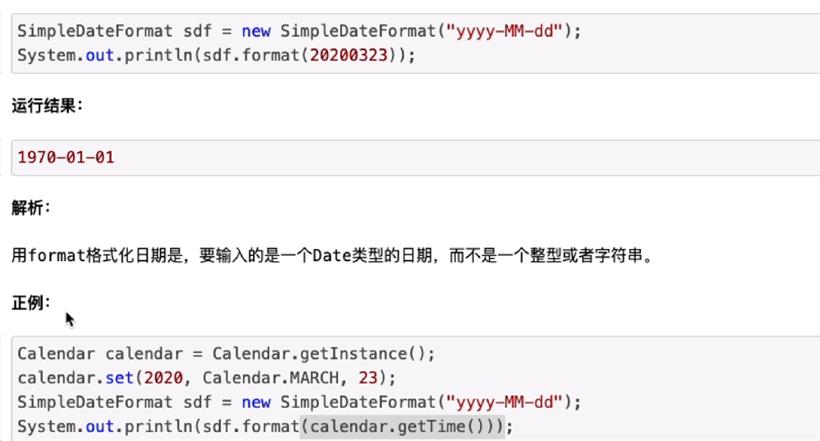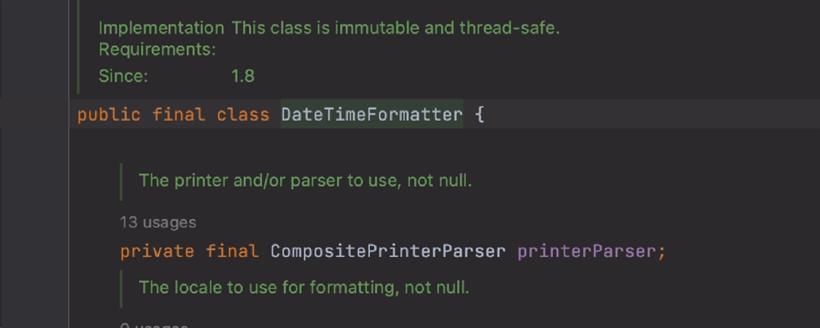- 联系我们
- duidaima.com 版权声明
- 闽ICP备2020021581号
-
 闽公网安备 35020302035485号
闽公网安备 35020302035485号
 闽公网安备 35020302035485号
闽公网安备 35020302035485号
这个bug是如何产生的呢?我给大家举个例子:比如产品要求支持查询一年之间内的交易流水,并且对这个时间区间的检验。用户选了开始时间和结束时间后,前端先检验,检验通过后,传到后端。后端也检验,然后开始查询。
1.假设当天时间2024.02.29日,客户选的开始时间是2023.02.28,结束时间是2024.02.29.
2.前端检验的时候,是用终止时间2024.02.29减12个月,得到开始时间2023.02.28,因此认为区间是合法的public class Test {
public static void main(String[] args) {
// 从前端获取的日期字符串
String startDateString = "20230228"; // 替换为从前端获取的startDate
String endDateString = "20240229"; // 替换为从前端获取的endDate
// 将字符串转换为LocalDate对象
DateTimeFormatter formatter = DateTimeFormatter.ofPattern("yyyyMMdd");
LocalDate startDate = LocalDate.parse(startDateString, formatter);
LocalDate endDate = LocalDate.parse(endDateString, formatter);
// 将startDate增加12个月
LocalDate startDatePlus12Months = startDate.plusMonths(12);
// 检查是否在时间区间范围内
if (startDatePlus12Months.isBefore(endDate)) {
System.out.println("时间区间超过一年");
throw new RuntimeException();
} else {
System.out.println("时间区间小于一年");
}
}
}
运行结果抛出了一场,输出时间区间超过一年。其实这个例子,就是我们是否把闰年的02.29日这一天算进去,怎么理解都算合理,但是就是要避免前后端不一致的坑。关于闰年处理的坑,我总结为主要是这几个方面:

String dateStr = "Wed Mar 18 10:00:00 2020";
DateTimeFormatter formatter = DateTimeFormatter.ofPattern("EEE MMM dd HH:mm:ss yyyy");
LocalDateTime dateTime = LocalDateTime.parse(dateStr, formatter);
System.out.println(dateTime);
运行结果:Exception in thread "main" java.time.format.DateTimeParseException: Text 'Wed Mar 18 10:00:00 2020' could not be parsed at index 0 at java.time.format.DateTimeFormatter.parseResolved0(DateTimeFormatter.java:1949) at java.time.format.DateTimeFormatter.parse(DateTimeFormatter.java:1851) at java.time.LocalDateTime.parse(LocalDateTime.java:492) at com.example.demo.SynchronizedTest.main(SynchronizedTest.java:19)解析:DateTimeFormatter 这个类默认进行本地化设置,如果默认是中文,解析英文字符串就会报异常。可以传入一个本地化参数(Locale.US)解决这个问题
String dateStr = "Wed Mar 18 10:00:00 2020";
DateTimeFormatter formatter = DateTimeFormatter.ofPattern("EEE MMM dd HH:mm:ss yyyy",Locale.US);
LocalDateTime dateTime = LocalDateTime.parse(dateStr, formatter);
System.out.println(dateTime);
五. Calendar设置时间的坑Calendar c = Calendar.getInstance(); c.set(Calendar.HOUR, 10); System.out.println(c.getTime());运行结果:Thu Mar 26 22:28:05 GMT+08:00 2020
Calendar c = Calendar.getInstance(); c.set(Calendar.HOUR_OF_DAY, 10);六.日期计算的坑


public class SimpleDateFormatTest {
private static final SimpleDateFormat sdf = new SimpleDateFormat("yyyy-MM-dd HH:mm:ss");
public static void main(String[] args) {
ThreadPoolExecutor threadPoolExecutor = new ThreadPoolExecutor(10, 100, 1, TimeUnit.MINUTES, new LinkedBlockingQueue<>(1000));
while (true) {
threadPoolExecutor.execute(() -> {
String dateString = sdf.format(new Date());
try {
Date parseDate = sdf.parse(dateString);
String dateString2 = sdf.format(parseDate);
System.out.println(dateString.equals(dateString2));
} catch (ParseException e) {
e.printStackTrace();
}
});
}
}
SimpleDateFormat 是个共享变量,多线程跑的时候,就会有问题:Exception in thread "pool-1-thread-49" java.lang.NumberFormatException: For input string: "5151." at java.lang.NumberFormatException.forInputString(NumberFormatException.java:65) at java.lang.Long.parseLong(Long.java:589) at java.lang.Long.parseLong(Long.java:631) at java.text.DigitList.getLong(DigitList.java:195) at java.text.DecimalFormat.parse(DecimalFormat.java:2051) at java.text.SimpleDateFormat.subParse(SimpleDateFormat.java:2162) at java.text.SimpleDateFormat.parse(SimpleDateFormat.java:1514) at java.text.DateFormat.parse(DateFormat.java:364) at com.example.demo.SimpleDateFormatTest.lambda$main$0(SimpleDateFormatTest.java:19) at java.util.concurrent.ThreadPoolExecutor.runWorker(ThreadPoolExecutor.java:1149) at java.util.concurrent.ThreadPoolExecutor$Worker.run(ThreadPoolExecutor.java:624) at java.lang.Thread.run(Thread.java:748) Exception in thread "pool-1-thread-47" java.lang.NumberFormatException: For input string: "5151." at java.lang.NumberFormatException.forInputString(NumberFormatException.java:65) at java.lang.Long.parseLong(Long.java:589) at java.lang.Long.parseLong(Long.java:631) at java.text.DigitList.getLong(DigitList.java:195) at java.text.DecimalFormat.parse(DecimalFormat.java:2051) at java.text.SimpleDateFormat.subParse(SimpleDateFormat.java:2162) at java.text.SimpleDateFormat.parse(SimpleDateFormat.java:1514) at java.text.DateFormat.parse(DateFormat.java:364) at com.example.demo.SimpleDateFormatTest.lambda$main$0(SimpleDateFormatTest.java:19) at java.util.concurrent.ThreadPoolExecutor.runWorker(ThreadPoolExecutor.java:1149) at java.util.concurrent.ThreadPoolExecutor$Worker.run(ThreadPoolExecutor.java:624) at java.lang.Thread.run(Thread.java:748)


TimeZone.setDefault(TimeZone.getTimeZone("Asia/Shanghai"));
SimpleDateFormat sdf = new SimpleDateFormat("yyyy-MM-dd HH:mm:ss");
System.out.println(sdf.parse("1986-05-04 00:30:00"));
运行结果:夏时令这几个时间可以注意一下哈,1986-05-04, 1987-04-12, 1988-04-10, 1989-04-16, 1990-04-15, 1991-04-14。
TimeZone.setDefault(TimeZone.getTimeZone("GMT+8"));
SimpleDateFormat sdf = new SimpleDateFormat("yyyy-MM-dd HH:mm:ss");
System.out.println(sdf.parse("1986-05-04 00:30:00"));